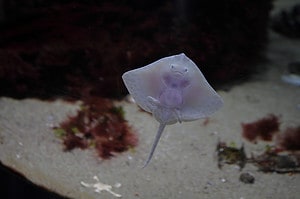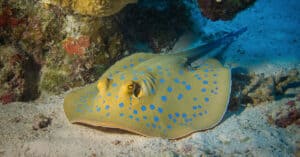Stingrays, also known as sea rays, are flat-bodied members of the Myliobatiformes order; the same order sharks are in. Within this order, there are eight distinct families of stingray, with over 200 species throughout the world. Stingrays live in tropical and subtropical waters, the depths of the ocean, and freshwater rivers. Sharks are close cousins, and stingrays come equipped with a deadly spinal blade sometimes called a stinger. They’re incredibly diverse, and have some of the most fascinating jaws and teeth in the animal kingdom.
Here, we’ll discover just what kind of teeth stingrays have, and what they use those teeth for. We’ll go in depth on the stingrays’ tooth cycles, whether or not they have sharp teeth, and just how they go about processing their food. Then, we’ll take a closer look at the structure of their jaws, and what their fascinating teeth are actually made of.
Do Stingrays Have Teeth?
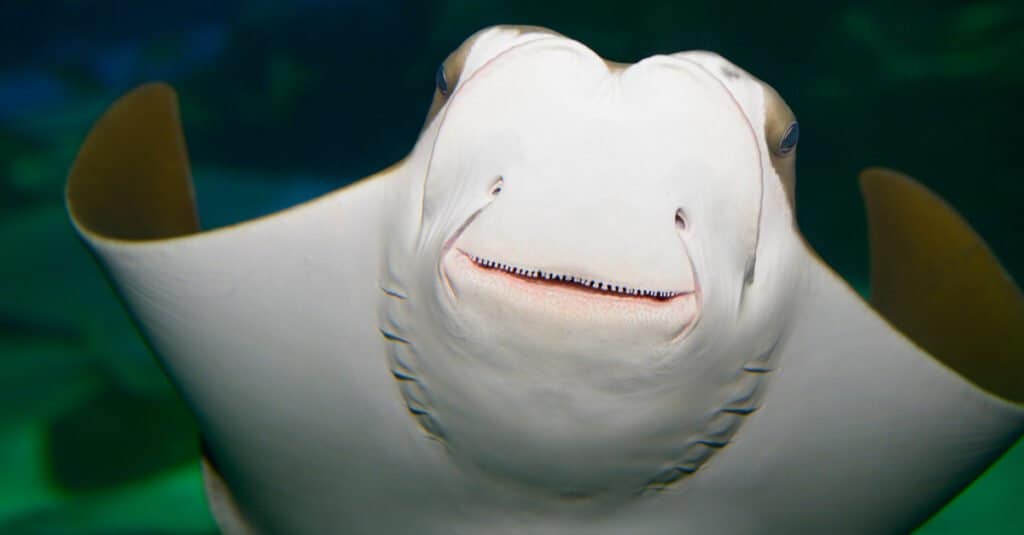
Stingrays have teeth; they’re made from modified placoid scales
©Reimar/Shutterstock.com
It might be hard to imagine, given how generally gelatinous stingrays look, but yes–they do have teeth. They may not be teeth in the traditional sense; say, in the way that sharks have teeth; but they do have a set of choppers to go with their cartilaginous bodies.
Stingray teeth are flattened, and made of modified placoid scales (also called dermal denticles). These are the same type of scales found on a shark’s body.
Do Stingrays Replace Teeth?
Like sharks, stingrays continuously shed and regrow their teeth throughout their lives. To do this, they are constantly developing new teeth below their current teeth. Because of this, the number of teeth in a stingray’s mouth are constantly fluctuating, but–they never have to worry about running out of teeth.
What Type of Teeth Do Stingrays Have?
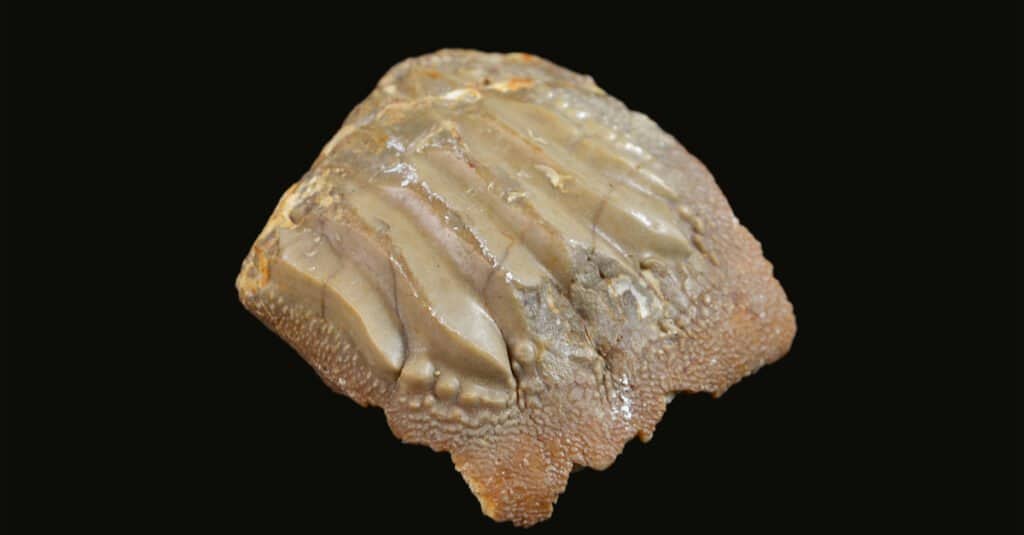
Fossilized stringray demonstrate how their teeth are modified scales.
©Andriy Kananovych/Shutterstock.com
The inside of a stingray’s mouth is a complex place–and it’s not where you want to be if you’re a small marine creature like a crustacean, mollusk, or fish. Still, not all stingray mouths are the same, and some actually use a filter feeding method to consume mostly krill. Manta rays are famous for this method of eating, their mouths, unlike other rays who have mouths on the bottom (ventral) side of their body, are located on the front of their body.
Other rays, those that more typically feed on creatures they find on the bottom of the ocean or river, have teeth that look a lot like two rolling pins, one on top of the other. Some have only two plates of teeth, while others have four–two on the top and two on the bottom. These plates are formed of a series of ‘teeth’–placoid scales, like the armored hide of a crocodile.
Most stingrays have these smooth teeth, but occasionally–their teeth aren’t so flat.
Are Stingray Teeth Sharp?
Stingrays spend most of the year with flat teeth, but in males, their teeth undergo some radical changes during the mating season.
Because stingrays mate back to belly, the male stingray needs to be able to hold onto the female stingray’s back. This would be nearly impossible with no arms, legs, claws, or sharp teeth. So, when mating season rolls around–the male stingray’s teeth actually change shape, becoming sharp. They use these newly pointed teeth to grip the female during mating. After mating season, their teeth go back to their normal, planar edges.
Do Stingrays Chew Their Food?
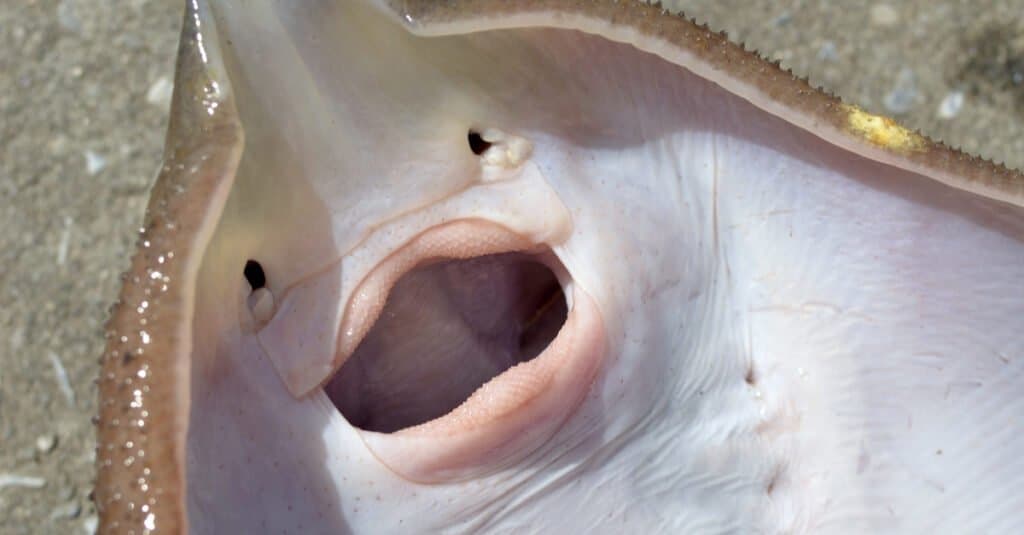
Stingrays chew their food using a series of flattened teeth and flexible jaws
©FashionStock.com/Shutterstock.com
With diets that consist largely of hard-shelled creatures like crabs, oysters, and clams–it’s imperative that stingrays have a way to chew their food. To enable mastication, they’ve evolved some pretty interesting teeth, jaws, and hunting techniques.
Through studies, scientists have discovered that stingrays use their teeth exclusively to chomp up prey. This is in contrast to other predators–like lions–who use their teeth to both hunt and chew. Instead, stingrays use their wide pectoral fins, sweeping them upwards in one rapid motion that creates suction, to literally suck prey into their mouths. Their teeth, jaws, and mouths play no role in the actual hunting process. They’re used exclusively to process food to prepare it for digestion.
Once the mollusk, insect, fish, or crustacean is in the stingray’s mouth, they begin the process of chewing. This includes repeatedly biting, spitting out, and sucking back in. as they do this, they’re also mashing the creature around between their planar jaws, crushing it as they go with their scale-like teeth. Their teeth, in conjunction with their incredible jaws, act like trash compactors; they make short work of even the toughest of shells.
Loose Jaws
To facilitate their chewing, stingrays have developed incredibly flexible jaws. Stingrays can chew not only up and down–but side to side, and back and forth. This is possible because of the very loose connections attaching the jaws to one another, and to the rest of the stingray.
Stingrays exhibit a type of chewing called ‘asymmetric’ chewing. This essentially means that stingrays can chew in all directions, and do. They roll their jaws around (they can extend them far forward, thanks to their loose jaw joints), masticating the prey as they go. Relatively, they’re more like a cow chewing its cud than they are like any other type of sea creature–at least when it comes to chewing.
What Are Stingray Teeth Made of?
Stingray teeth may look a little different, but they’re made of essentially the same materials as human teeth. Like our teeth, stingray teeth have a pulpy center that’s full of blood vessels and nerves. Surrounding that is a layer of dentin, the primary material that all teeth are made of. A layer of hard enamel coats the dentin, and, when the tooth is ready, it simply sheds out of the mouth. A new tooth soon replaces the old tooth, and the stingray keeps a full mouth of pulp-dentin-enamel laden teeth all its life.
The photo featured at the top of this post is © Vicki L. Miller/Shutterstock.com
Thank you for reading! Have some feedback for us? Contact the AZ Animals editorial team.



